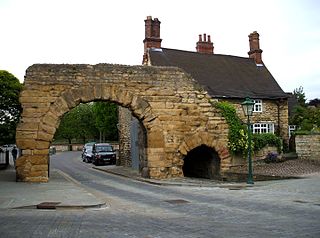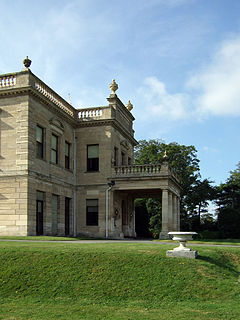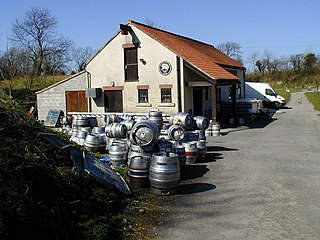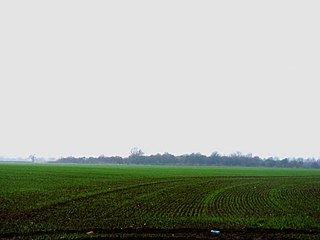
Ermine Street is a major Roman road in England that ran from London (Londinium) to Lincoln and York (Eboracum). The Old English name was Earninga Strǣt (1012), named after a tribe called the Earningas, who inhabited a district later known as Armingford Hundred, around Arrington, Cambridgeshire, and Royston, Hertfordshire. "Armingford", and "Arrington" share the same Old English origin. The original Celtic and Roman names for the route remain unknown. It is also known as the Old North Road from London to where it joins the A1 Great North Road near Godmanchester.

Woodlands is a model village 4 miles (6 km) north-west of Doncaster in South Yorkshire, England. The village lies adjacent to Highfields and Adwick le Street within the City of Doncaster. The colliery village was designed and built in the early 20th century by the architect Percy Houfton as tied cottages for the miners of the neighbouring Brodsworth Colliery. In an era of model villages such as Saltaire, Port Sunlight and Bournville, Woodlands, with extensive open spaces, many different designs of houses, and overall living conditions excellent for their time, possibly represents the height of the model village movement. The village is a conservation area.

Wombwell is a town in the Metropolitan Borough of Barnsley in South Yorkshire, England. The town in the 2011 census was split between a ward called Wombwell, as well as small parts that fell under two other wards called Darfield and Stairfoot. Added together, these list the town's population as roughly 15,316.

Adwick le Street is a village in the City of Doncaster, South Yorkshire, England. The Adwick ward of Doncaster Metropolitan Borough Council had a population of 15,911 at the 2011 Census. It is situated north-west of Doncaster. Under the 2011 census, the settlement had a population of 10,507.

Skellow is a village in rural South Yorkshire part of the Metropolitan Borough of Doncaster, England. Historically part of the West Riding of Yorkshire, the village is roughly 5 miles (8 km) north-west of Doncaster. The village falls in the Askern Spa Ward of Doncaster MBC. To the north and south is mixed farmland, the A1 runs immediately along the western edge of the village, and to the east Skellow merges with the adjacent village of Carcroft along the B1220 road.

Barnsdale, or Barnsdale Forest, is an area of South and West Yorkshire, England. The area falls within the modern-day districts of Doncaster and Wakefield. Barnsdale was historically part of the West Riding of Yorkshire. Barnsdale lies in the immediate vicinity north and northwest of Doncaster, and which was formerly forested and a place of royal hunts, and also renowned as a haunt of the outlaw Robin Hood in early ballads.

Brodsworth is a village, civil parish and suburb of Doncaster in the City of Doncaster district in South Yorkshire, England. situated about five miles north-west of Doncaster. According to the 2001 census, it had a population of 2,875, increasing to 2,936 at the 2011 Census.

Bardsey, West Yorkshire, England is a small village in the City of Leeds metropolitan borough, 8 miles (13 km) north east of Leeds city centre. The village is in the LS17 Leeds postcode district. It is part of the civil parish of Bardsey cum Rigton. The village itself lies just off the A58 road between Leeds and Wetherby.

The A638 is a major road in England. It runs between the A1 at Markham Moor, Nottinghamshire and Chain Bar Interchange - Junction 26 of the M62 motorway, south of Bradford in West Yorkshire.
The South Yorkshire Railway was a railway company with lines in the West Riding of Yorkshire, England.

The West Riding and Grimsby Railway was a railway company that promoted a line between Wakefield and Doncaster, in Yorkshire, England. There was also a branch line connection from Adwick le Street to Stainforth, which gave access towards Grimsby. The company was promoted independently, but it was sponsored by the Manchester, Sheffield and Lincolnshire Railway and the Great Northern Railway, and became jointly owned by them.

Cropton is a village and civil parish in the Ryedale district of North Yorkshire, England. It is on the border of the North York Moors National Park, 3 miles (5 km) north-west of Pickering.

Hanging Wood is an area of woodland situated between the old Great North Road and the Roman Road, and between the mining villages of Highfields and Woodlands in South Yorkshire, England. The Woodlands wildlife park and an ornamental lake, Highfields Lake are features of the wood, as is Woodlands, a former country house, now a social club.

Carcroft is a rural village and civil parish in the Metropolitan Borough of Doncaster, South Yorkshire, England. Historically part of the West Riding of Yorkshire, the village is roughly six miles north-north west of Doncaster. At the time of the 2011 Census the village fell within the ward of Adwick in the Doncaster MBC.
Roman Ridge is a bridleway that was part of the Roman road of Ermine Street, between Scawsby and Redhouse to the north of Doncaster, England.

Hangthwaite Castle was an earthwork motte and bailey castle founded by Nigel Fozzard. It stood in the 11th century and is situated just north of Scawthorpe, Doncaster, South Yorkshire, England. Originally, the site was known as Langthwaite, though it changed over the years to Hangthwaite. In the 13th century, a fortified house called Radcliffe Moat replaced Hangthwaite Castle as a local fortification. Nowadays, only the motte and the ditches remain. Encased by the wide wet ditch, the motte defends a bean-shaped eastern bailey and a small north-western mound, which is possibly a barbican.

While there are many castles in South Yorkshire, the majority are manor houses and motte-and-bailey which were commonly found in England after the Norman Conquest.

The A1500 is an 'A' road entirely within the English county of Lincolnshire. It links the A156 at Marton with the A15 south of RAF Scampton via Sturton by Stow.
Adwick le Street and Carcroft is a ward in the metropolitan borough of Doncaster, South Yorkshire, England. The ward contains 33 listed buildings that are recorded in the National Heritage List for England. Of these, one is listed at Grade II*, the middle of the three grades, and the others are at Grade II, the lowest grade. The ward contains the villages of Adwick le Street and Carcroft, and the surrounding area. Most of the listed buildings are in the model village of Woodlands, and consist of houses built for the Brodsworth Colliery Company, and designed by Percy Houfton in Arts and Crafts style. Also in the model village are a church and two schools. Elsewhere, the listed buildings consist of an older church, the remains of a churchyard cross and a memorial in the churchyard, a former water mill, a large house later used as a club, a war memorial in the form of a clock tower, and a miners' welfare institute.

















